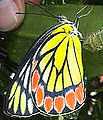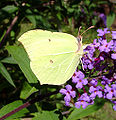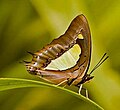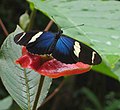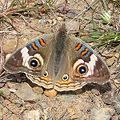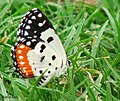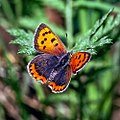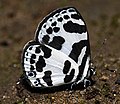Butterfly
| Butterflies | |
|---|---|

| |
| A Viceroy, mimic of the Monarch | |
| Scientific classification | |
| Kingdom: | |
| Phylum: | |
| Class: | |
| Order: | |
| (unranked): | |
| Families | |
| |
A butterfly is an insect of the order Lepidoptera, it belongs to either the Hesperioidea (the skippers) or Papilionoidea (all other butterflies) Superfamilies. Some authors have also suggested the inclusion of the superfamily Hedyloidea, the American butterfly moths.[1] They are notable for their unusual life cycle with a larval caterpillar stage, an inactive pupal stage and a spectacular metamorphosis into a familiar and colourful winged adult form. The diverse patterns formed by their brightly coloured wings and their erratic-yet-graceful flight have made butterfly watching a popular hobby.
Etymology
The Old English word for butterfly was buttorfleoge apparently because butterflies were thought to steal milk. A similar word occurs in Dutch and German originating from the same belief. This is believed to have led to the evolution of its present name form - butterfly.[2]
An alternative folk etymology, prevalent in Great Britain, is that it originated as a contraction of butter-coloured fly referring to the Brimstone Butterfly Gonepteryx rhamni, often the first butterfly of spring. Another such view is that the word butterfly came from a metathesis of "flutterby".[3]
Origin and distribution
Butterflies are believed to have evolved from a branch of ancestral forms of moths. This branching is believed to have happened in the Cretaceous Period, 65 million to 135 million years ago.[4] The oldest known fossil is a Metalmark butterfly (Voltinia dramba) from 25 million year old Dominican amber.[5]
Butterflies are today distributed throughout the world except in the very cold and arid regions. There are an estimated 18,000 species of butterflies.
Classification
This template is a customized wrapper for {{[[Template:{{{1}}}|{{{1}}}]]}}. Any field from {{[[Template:{{{1}}}|{{{1}}}]]}} can work so long as it is added to this template first. Questions? Just ask here or over at [[Template talk:{{{1}}}]]. |
|

|-
|

|}
Presently butterflies are classified in two superfamilies, Hesperioidea, consisting of the 'skippers' and Papilionoidea or 'true butterflies'. These are sister taxa, so the butterflies collectively are thought to constitute a true clade. Some taxonomists place them all in superfamily Papilionoidea, distinguishing the skippers from the other butterflies at the series level only. In this system, Papilionoidea consists of the series Hesperiiformes (with one family only, the skipper family Hesperiidae) and the series Papilioniformes (with five families).
Butterfly families
The five families of true butterflies usually recognized in the Papilionoidea are:-
- Family Papilionidae, the Swallowtails and Birdwings
- Family Pieridae, the Whites and Yellows
- Family Lycaenidae, the Blues and Coppers, also called the Gossamer-Winged Butterflies
- Family Riodinidae, the Metalmark butterflies
- Family Nymphalidae, the Brush-footed butterflies
Taxonomic issues
A study combining morphological and molecular data concluded that Hesperiidae, Papilionidae, Pieridae, Lycaenidae and Riodinidae could all be strongly supported as monophyletic groups, but the status of Nymphalidae is uncertain. Lycaenidae and Riodinidae were confirmed as sister taxa, and Papilionidae as the outgroup to the rest of the true butterflies, but the location of Pieridae within the pattern of descent was unclear, with different lines of evidence suggesting different conclusions. The data suggested that the moths of Hedyloidea are indeed more closely related to the butterflies than to other moths.[6]
Some older classifications recognize additional families, for example Danaidae, Heliconiidae, Libytheidae and Satyridae, but modern classifications treat these as subfamilies within the Nymphalidae.
Butterflies and moths
The dichotomous classfication of lepidopterans into butterflies and moths is one that is popular but not used in taxonomy. The folk groups of butterflies and moths can be distinguished using several features but there are exceptions to most of these rules. (See difference between a butterfly and a moth)
The four stages in the lifecycle of a butterfly

Unlike many insects, butterflies do not experience a nymph period, but instead go through a pupal stage which lies between the larva and the adult stage (the imago). Butterflies are termed as holometabolous insects, and go through complete metamorphosis.
It is a popular belief that butterflies have very short life spans. However, butterflies in their adult stage can live from a week to nearly a year depending on the species. Many species have long larval life stages while others can remain dormant in their pupal and egg stages and thereby survive winters.[7]
Egg

Butterfly eggs consist of a hard-ridged outer layer of shell, called the chorion. This is lined with a thin coating of wax which prevents the egg from drying out before the larva has had time to fully develop. Each egg contains a number of tiny funnel-shaped openings at one end, called micropyles; the purpose of these holes is to allow sperm to enter and fertilize the egg. Butterfly and moth eggs vary greatly in size between species, but they are all either spherical or ovate.
Butterfly eggs are fixed to a leaf with a special glue which hardens rapidly. As it hardens it contracts deforming the shape of the egg. This glue is easily seen surrounding the base of every egg forming a meniscus. The nature of the glue is unknown, and is a suitable subject for research. The same glue is produced by a pupa to secure the setae of the cremaster. This glue is so hard that the silk pad, to which the setae are glued, cannot be separated.
Eggs are usually laid on plants. Each species of butterfly has its own hostplant range and while some species are restricted to just one species, others use a range of plant species, often members of a common family.
The egg stage lasts a few weeks in most butterflies but eggs laid close to winter especially in temperate regions go through a diapause stage and the hatching may take place only in spring.
Caterpillars

Larvae, or caterpillars, are multi-legged eating machines. They consume plant leaves and spend practically all of their time in search of food. Although most caterpillars are herbivorous, a few species such as Spalgis epius and Liphyra brassolis are entomophagous (insect eating). Some larvae, especially those of the Lycaenidae form mutualistic associations with ants. They communicate with the ants using vibrations that are transmitted through the substrate as well as using chemical signals.[8][9] The ants provide some degree of protection to these larvae and they in turn gather honeydew secretions.
Caterpillars mature through a series of stages, called instars. Near the end of each instar, the larva undergoes a process called apolysis, in which the cuticle, a mixture of chitin and specialized proteins, is released from the epidermis and the epidermis begins to form a new cuticle beneath. At the end of each instar, the larva moults the old cuticle, and the new cuticle rapidly hardens and pigments. Development of butterfly wing patterns begins by the last larval instar.
Butterfly caterpillars have three pairs of true legs from the thoracic segments and upto 6 pairs of prolegs arising from the abdominal segments. These prolegs have rings of tiny hooks called crochets that help them grip the substrate.
Some caterpillars have the ability to inflate parts of their head to appear snake-like. Many have false eye-spots to enhance this effect. Some caterpillars have special structures called osmeteria which are everted to produce smelly chemicals. These are used in defense.
Host plants often have toxic substances in them and caterpillars are able to sequester these substances and retain them into the adult stage. This helps making them unpalatable to birds and other predators. Such unpalatibility is advertised using bright red, orange, black or white warning colours. The toxic chemicals in plants are often evolved specifically to prevent them from being eaten by insects. Insects in turn develop countermeasures or make use of these toxins for their own survival. This evolutionary arms race has lead to coevultion in the insects and their host plants.[10]
Wing development

Wings or wing pads are not visible on the outside of the larva, but when larvae are dissected, tiny developing wing disks can be found on the second and third thoracic segments, in place of the spiracles that are apparent on abdominal segments.
Wing disks develop in association with a trachea that runs along the base of the wing, and are surrounded by a thin peripodial membrane, which is linked to the outer epidermis of the larva by a tiny duct.
Wing disks are very small until the last larval instar, when they increase dramatically in size, are invaded by branching tracheae from the wing base that precede the formation of the wing veins, and begin to express molecular markers in patterns associated with several landmarks of the wing.
Near pupation, the wings are forced outside the epidermis under pressure from the hemolymph, and although they are initially quite flexible and fragile, by the time the pupa breaks free of the larval cuticle they have adhered tightly to the outer cuticle of the pupa (in obtect pupae). Within hours, the wings form a cuticle so hard and well-joined to the body that pupae can be picked up and handled without damage to the wings.
This template is a customized wrapper for {{[[Template:{{{1}}}|{{{1}}}]]}}. Any field from {{[[Template:{{{1}}}|{{{1}}}]]}} can work so long as it is added to this template first. Questions? Just ask here or over at [[Template talk:{{{1}}}]]. |
|

|

|}
Pupa
When the larva is fully grown, hormones such as prothoracicotropic hormone (PTTH) are produced. At this point the larva stops feeding and begins "wandering" in the quest of a suitable pupation site, often the underside of a leaf.
The larva transforms into a pupa (or chrysalis) by anchoring itself to a subtrate and moulting for the last time. The chrysalis is usually incapable of movement, although some species can rapidly move the abdominal segments or produce sounds to scare potential predators.
The pupal transformation into a butterfly through metamorphosis has held great appeal to mankind. To transform from the miniature wings visible on the outside of the pupa into large structures usable for flight, the pupal wings undergo rapid mitosis and absorb a great deal of nutrients. If one wing is surgically removed early on, the other three will grow to a larger size. In the pupa, the wing forms a structure that becomes compressed from top to bottom and pleated from proximal to distal ends as it grows, so that it can rapidly be unfolded to its full adult size. Several boundaries seen in the adult color pattern are marked by changes in the expression of particular transcription factors in the early pupa.
Adult or Imago
The adult, sexually mature, stage of the insect is known as the imago. As Lepidoptera, butterflies have four wings that are covered with tiny scales (see photo), but, unlike moths, the fore and hindwings are not hooked together, permitting a more graceful flight. An adult butterfly has six legs, but in the nymphalids, the first pair is reduced. After it emerges from its pupal stage, a butterfly cannot fly until the wings are unfolded. A newly-emerged butterfly needs to spend some time inflating its wings with blood and letting them dry, during which time it is extremely vulnerable to predators.
External morphology
- 1 - Antenna
- 2 - Head
- 3 - Compound eye
- 4 - Proboscis
- 5 - Front leg
- 6 - Middle leg
- 7 - Thorax
- 8 - Femur
- 9 - Tibia of a hind leg
- 10 - Tarsus of a hind leg
- 11 - Abdominal segment
- 12 - Abdomen
- 13 - Hindwing
- 14 - Spur or tail
- 15 - Outer margin
- 16 - Apex
- 17 - Vein
- 18 - Forewing
- 19 - Costal margin
Scales
Butterflies are characterized by their scale covered wings.
The colouration of butterfly wings is created by minute scales. These scales are pigmented with melanins that give them blacks and browns, but blues, greens, reds and iridescence are usually created not by pigments but the microstructure of the scales. This structural colouration is the result of coherent scattering of light by microstructure of the scales.[11][12][13]
Polymorphism
Many adult butterflies exhibit polymorphism, showing differences in appearance. These variations include geographic variants and seasonal forms. In addition many species have females in multiple forms, often with mimetic forms. Sexual dimorphism in colouration and appearance is widespread in butterflies. In addition many species show sexual dimorphism in the patterns of ultraviolet reflectivity, while otherwise appearing identical to the unaided human eye.
Genetic abnormalities such as gynandromorphs also occur from time to time.
Batesian and Mullerian mimicry in butterflies is common. Wing markings called eyespots are present in some species; these may have an automimicry role for some species. In others, the function may be intraspecies communication, such as mate attraction. In several cases, however, the function of butterfly eyespots is not clear, and may be an evolutionary anomaly related to the relative elasticity of the genes that encode the spots.[14][15]
Habits
Butterflies feed primarily on nectar from flowers. Some also derive nourishment from pollen, tree sap, rotting fruit, dung, and dissolved minerals in wet sand or dirt. Butterflies play an important ecological role as pollinators.

As adults, butterflies consume only liquids and these are sucked by means of their proboscis. They feed on nectar from flowers and also sip water from damp patches. This they do for water, for energy from sugars in nectar and for sodium and other minerals which are vital for their reproduction. Several species of butterflies need more sodium than provided by nectar. They are attracted to sodium in salt and they sometimes land on people, attracted by human sweat. Besides damp patches, some butterflies also visit dung, rotting fruit or carcasses to obtain minerals and nutrients. In many species, this behaviour is restricted to the males and studies have suggested that the nutrients collected are provided as a nuptial gift along with the spermatophore during mating.[16]
Butterflies sense the air for scents, wind and nectar using their antennae. The antennae come in various shapes and colours. The hesperids have a pointed angle or hook to the antennae, while most other families show knobbed antennae. The antennae are richly covered with sensillae. Chemoreceptors are also present on the tarsi and these work only on contact. Many butterflies use chemical signals, pheromones, and specialized scent scales (androconia) and other structures (coremata or 'Hair pencils' in the Danaidae) are developed in some species.
Vision is well developed in butterflies and most species are sensitive to the ultraviolet spectrum. Many species show sexual dimorphism in the patterns of UV reflective patches.[17] Colour vision may be widespread but has been demonstrated in only a few species.[18][19]
Some butterflies have organs of hearing and some species are also known to make stridulatory and clicking sounds.[20]
Many butterflies, such as the Monarch butterfly, are migratory and capable of long distance flights. They migrate during the day and use the sun to orient themselves. They also perceive polarized light and use it for orientation when the sun is hidden.[21]
Many species of butterfly maintain territories and actively chase other species or individuals that may stray into them. Some species will bask or perch on chosen perches. The flight styles of butterflies are often characteristic and some species have courtship flight displays. Basking is an activity which is commoner in the cooler hours of the morning. Many species will orient themselves to gather heat from the sun. Some species have evolved dark wingbases to help in gathering more heat and this is especially evident in alpine forms.[22]
Flight

Like many other members of the insect world, the lift generated by butterflies is more than what can be accounted for by steady-state, non-transitory aerodynamics. Studies using Vanessa atalanta in a windtunnel show that they use a wide variety of aerodynamic mechanisms to generate force. These include wake capture, vortices at the wing edge, rotational mechanisms and Weis-Fogh 'clap-and-fling' mechanisms. The butterflies were also able to change from one mode to another rapidly.[23] (See also Insect flight)
Migration
Many butterflies migrate over long distances. Particularly famous migrations being those of the Monarch butterfly from Mexico to North America, a distance of about 4,000 to 4,800 kilometres (2500-3000 miles). Other well known migratory species include the Painted Lady and several of the Danaine butterflies. Spectacular and large scale migrations associated with the Monsoons are seen in peninsular India.[24] Migrations have been studied in more recent times using wing tags and also using stable hydrogen isotopes.[25][26]
Butterflies have been shown to navigate using time compensated sun compasses. They can see polarized light and therefore orient even in cloudy conditions. The polarized light in the region close to the ultraviolet spectrum is suggested to be particular important.[27]
It is suggested that most migratories butterflies are those that belong to semi-arid areas where breeding seasons are limited.[28]
Defense
Butterflies have many predators in all stages of their lives and have evolved a variety of defenses. In addition parasitoids can attack the early stages.
Chemical defenses are widespread and are often based on chemicals of plant origin. In many cases the plants themselves have evolved these toxic substances to reduce attack to them. These defense mechanisms are effective only if they are also well advertised. Many unpalatable butterflies are brightly coloured. This has led to unprotected butterflies evolving forms that appear like the unpalatable butterflies. These mimetic forms are usually restricted to the females.
Cryptic colouration is found in many butterflies. Some like the oakleaf butterfly are remarkable imitations of leaves.[29] As caterpillars, many defend themselves by freezing and appearing like sticks or branches. Some papilionid caterpillars resemble bird dropping in their early instars. Some caterpillars have hairs and bristly structures that provide protection while others are gregarious and form dense aggregations. Some species also form associations with ants and gain their protection (See Myrmecophile).
Behavioural defenses include perching and wing positions to avoid being conspicuous. Some female Nymphalid butterflies are known to guard their eggs from parasitoid wasps.[30]
Eyespots and tails are found in many lycaenid butterflies and these divert the attention of predators from the more vital head region. An alternative theory is that these cause ambush predators such as spiders to approach from the wrong end and allow for early visual detection.[31]
Some popular species
There are between 15,000 and 20,000 species of butterflies worldwide. Some well known species from around the world include:
- Swallowtails and Birdwings, Family Papilionidae
- Common Yellow Swallowtail, Papilio machaon
- Spicebush Swallowtail, Papilio troilus
- Lime Butterfly, Papilio demoleus
- Ornithoptera genus (Birdwings; the largest butterflies)
- Whites or Yellows, Family Pieridae
- Small White, Pieris rapae
- Green-veined White, Pieris napi
- Common Jezebel, Delias eucharis
- Blues and Coppers or Gossamer-Winged Butterflies, Family Lycaenidae
- Xerces Blue, Glaucopsyche xerces
- Karner Blue, Lycaeides melissa samuelis (endangered)
- Red Pierrot, Talicada nyseus
- Metalmark butterflies, Family Riodinidae
- Lange's Metalmark Butterfly
- Plum Judy, Abisara echerius
- Brush-footed butterflies, Family Nymphalidae
- Painted Lady, or Cosmopolite, Vanessa cardui
- Monarch butterfly, Danaus plexippus
- Morpho genus
- Speckled Wood, Pararge aegeria
In culture
Art

Artistic depictions of butterflies have been used in many cultures including Egyptian hieroglyphics 3500 years ago.[32] Today butterflies are widely used in various objects of art.
Symbolism
According to the “Butterflies” chapter in Kwaidan: Stories and Studies of Strange Things, by Lafcadio Hearn, a butterfly is seen as the personification of a person's soul, whether they be living, dying, or already dead. One Japanese superstition says that if a butterfly enters your guestroom and perches behind the bamboo screen, the person whom you most love is coming to see you. On the contrary, large numbers of butterflies are viewed as bad omens. When Taira no Masakado was secretly preparing for his famous revolt, there appeared in Kyoto so vast a swarm of butterflies that the people were frightened—-thinking the apparition to be a portent of coming evil.[33]
According to Mircea Eliade's Encyclopedia of Religion, some of the Nagas of Manipur trace their ancestry from a butterfly.[2]
In Chinese culture two butterfly flying together is a symbolism for a loving couple. Also a famous Chinese folk story called Butterfly Lovers (a Chinese Romeo and Juliet story).
In some old culture Butterfly also symbolize rebirth into a new life after being inside a cocoon for a while.
Butterfly alphabet
Over a period of twenty-six years, nature photographer Kjell B. Sandved managed to discover all twenty-six letters of the Latin alphabet and numerals one through nine on the wings of butterflies.
Technological inspiration
Studies on the reflection of light by the scales on wings of swallowtail butterflies have to led to the innovation of more efficient Light emitting diodes.[34]
The structural colouration of butterflies is inspiring nanotechnology research to produce paints that do not use toxic pigments and in the development of new display technologies.[35]
Gallery
Family Papilionidae- The Swallowtails
-
Scarce Swallowtail,
Iphiclides podalirius. -
Palawan Birdwing,
Troides trojana. -
Cairns Birdwing,
Ornithoptera priamus. -
Blue Mormon,
Papilio polymnestor. -
Orchard Swallowtail Butterfly,
Papilio aegeus. -
Crimson Rose,
Pachliopta hector. -
Pipevine Swallowtail,
Battus philenor. -
Common Mime,
Chilasa clytia.
Family Pieridae - The Whites and Yellows
-
Green-veined White,
Pieris napi. -
The Orange Tip,
Anthocharis cardamines. -
Common Jezebel,
Delias eucharis. -
Common Brimstone,
Gonepteryx rhamni.
Family Riodinidae - The Metalmarks, Punches and Judies
-
The Plum Judy,
Abisara echerius -
Punchinello,
Zemeros flegyas -
Tailed Judy,
Abisara neophron -
Lange's Metalmark.
Family Nymphalidae - The Brush-footed Butterflies
-
Morpho rhetenor helena a morphine from
South America. -
Julia Heliconian,
Dryas julia. -
Glasswing butterfly,
Greta oto. -
Peacock Butterfly,
Inachis io. -
Comma Butterfly,
Polygonia c-album. -
Common Buckeye,
Junonia coenia. -
Crimson Patch,
Chlosyne janais.
Family Lycaenidae - The Blues
-
Red Pierrot,
Talicada nyseus. -
Small Copper,
Lycaena phlaeas. -
Monkey Puzzle,
Rathinda amor. -
Banded Blue Pierrot,
Discolampa ethion.
See also
- List of British butterflies
- List of official state butterflies for each state of the U.S.A.
- List of butterflies of India
- Butterflies of Taiwan
- Butterfly Zoo
Cited references
- ^ Scoble, M.J. (1986) The structure and affinities of the Hedyloidea: a new concept of the butterflies. Bull. Brit. Mus. (nat. Hist.) (Ent.), 53: 251-286.
- ^ a b Rabuzzi,Matthew 1997 Butterfly Etymology. Cultural Entomology Digest. 4 [1] Accessed November 2006
- ^ J. Akers Pence Butterfly Etymology Accessed November 9, 2006
- ^ American Museum of Natural History. Accessed November 2006
- ^ Hall, J.P.W., R.K. Robbins, and D. Harvey. 2004.Extinction and biogeography in the Caribbean: new evidence from a fossil riodinid butterfly in Dominican amber. Proc. R. Soc. Lond., Biol. sci. 271(1541):797-801
- ^ Wahlberg, N., M. F. Braby, A. V. Z. Brower, R. de Jong, M.-M. Lee, S. Nylin, N. E. Pierce, F. A. H. Sperling, R. Vila, A. D. Warren & E. Zakharov. 2005. Synergistic effects of combining morphological and molecular data in resolving the phylogeny of butterflies and skippers. Proceedings of the Royal Society, Series B (Biological Sciences) 272, 1577-1586.
- ^ Powell, J. A. 1987. Records of prolonged diapause in Lepidoptera. J. Res. Lepid. 25: 83-109.
- ^ DeVries, P. J. 1988. The larval ant-organs of Thisbe irenea (Lepidoptera: Riodinidae) and their effects upon attending ants. Zool. J. Linn. Soc. 94:379-393.
- ^ DeVries, P. J. 1990. Enhancement of symbioses between butterfly caterpillars and ants by vibrational communication. Science 248:1104-1106.
- ^ Ehrlich, P. R., and P. H. Raven. 1964. Butterflies and plants: a study in coevolution. Evolution 18:586–608
- ^ Mason C. W., 1927 Structural colours in insects. II. Iridescent colours. J. Phys. Chem., 31, 321-354
- ^ Vukusic, P., J.R.Sambles, and H. Ghiradella (2000) Optical Classification of Microstructure in Butterfly Wing-scales. Photonics Science News, 6, 61-66 [2]
- ^ Prum, Richard O., Tim Quinn and Rodolfo H. Torres 2006. Anatomically diverse butterfly scales all produce structural colours by coherent scattering. Journal of Experimental Biology 209, 748-765 doi: 10.1242/jeb.02051 Full text
- ^
Brunetti CR; et al. (2001). "The generation and diversification of butterfly eyespot color patterns". J. of Cell Biology. 11 (20): 1578–85. PMID: 11676917.
{{cite journal}}:|access-date=requires|url=(help); Explicit use of et al. in:|author=(help); Unknown parameter|month=ignored (help) - ^ Brakefield, PM; et al. (1996). "Development, plasticity and evolution of butterfly eyespot patterns". Nature (384): 236–242.
{{cite journal}}:|access-date=requires|url=(help); Explicit use of et al. in:|author=(help) - ^ Molleman Freerk, Grunsven Roy H. A., Liefting Maartje, Zwaan Bas J., Brakefield Paul M. (2005) Is male puddling behaviour of tropical butterflies targeted at sodium for nuptial gifts or activity? Biol. J. Linn. Soc. 86, (3):345-361
- ^ Obara Y, Hidaki T. (1968). Recognition of the female by the male, on the basis of ultra-violet reflection, in the white cabbage butterfly Pieris rapae crucivora Boisduval. Proc. Japan Acad., 44: 829-832.
- ^ Tadao Hirota and Yoshiomi Kato 2004 Color discrimination on orientation of female Eurema hecabe (Lepidoptera: Pieridae) Applied Entomology and Zoology Vol. 39:229-233 [3]
- ^ Michiyo Kinoshita, Naoko Shimada And Kentaro Arikawa (1999) Colour vision of the foraging swallowtail butterfly Papilio xuthus. The Journal of Experimental Biology 202:95–102 [4]
- ^ Swihart, S. L (1967). Hearing in butterflies. J. Insect Physiol 13, 469
- ^ Reppert, Steven M.; Haisun Zhu; White, Richard H. (2004) Polarized light helps monarch butterflies navigate. Current biology 14(2):155-158
- ^ Ellers, J. and Carol L. Boggs (2002) The evolution of wing color in Colias butterflies: Heritability, Sex Linkage, and population divergence. Evolution, 56(4):836–840 [5]
- ^ Srygley, R. B. and A. L. R. Thomas (2002) Aerodynamics of insect flight: flow visualisations with free flying butterflies reveal a variety of unconventional lift-generating mechanisms. Nature 420: 660-664. PDF
- ^ Williams, C. B. 1927 A study of butterfly migration in south India and Ceylon, based largely on records by Messrs. G Evershed, E.E.Green, J.C.F. Fryer and W. Ormiston. Trans. Ent. Soc. London 75:1-33
- ^ Urquhart, F. A. & N. R. Urquhart. 1977. Overwintering areas and migratory routes of the Monarch butterfly (Danaus p. plexippus, Lepidoptera: Danaidae) in North America, with special reference to the western population. Can. Ent. 109: 1583-1589
- ^ Wassenaar L.I., Hobson K.A. 1998. Natal origins of migratory monarch butterflies at wintering colonies in Mexico: new isotopic evidence. Proc Natl Acad Sci U S A. 95(26):15436-9. Full text
- ^ Ivo Sauman, Adriana D. Briscoe, Haisun Zhu, Dingding Shi, Oren Froy, Julia Stalleicken, Quan Yuan, Amy Casselman, and Steven M. Reppert (2005) Connecting the Navigational Clock to Sun Compass Input in Monarch Butterfly Brain. Neuron. 46:457-467 [6]
- ^ Southwood, T. R. E. 1962. Migration of terrestrial arthropods in relation to habitat. Biol. Rev. 37:171-214
- ^ Robbins, Robert K. (1981) The "False Head" Hypothesis: Predation and Wing Pattern Variation of Lycaenid Butterflies. American Naturalist 118(5):770-775
- ^ Nafus, D. M. and I. H. Schreiner (1988) Parental care in a tropical nymphalid butterfly Hypolimas anomala. Anim. Behav. 36: 1425- 143
- ^ William E. Cooper, Jr. (1998) Conditions favoring anticipatory and reactive displays deflecting predatory attack. Behavioral Ecology 9(6):598-604
- ^ Larsen, Torben (1994) Butterflies of Egypt. Saudi Aramco world. 45(5):24-27 Online
- ^ Hearn, Lafcadio (1904). Kwaidan: Stories and Studies of Strange Thing. Dover Publications, Inc. ISBN 0-486-21901-1.
- ^ Vukusic, Pete and Ian Hooper. 2005. Directionally Controlled Fluorescence Emission in Butterflies Science. 310(5751):1151 DOI: 10.1126/science.1116612
- ^ Biomimetics at Qualcomm
Other references
- Boggs, C., Watt, W., Ehrlich, P. 2003. Butterflies: Evolution and Ecology Taking Flight. University of Chicago Press, Chicago, USA.
- Heppner, J. B. 1998. Classification of Lepidoptera. Holarctic Lepidoptera, Suppl. 1.
- Pyle, R. M. 1992. Handbook for Butterfly Watchers. Houghton Mifflin. First published, 1984. ISBN 0-395-61629-8
Field guides to butterflies

- Butterflies of North America, Jim P. Brock and Kenn Kaufman (2003)
- Butterflies through Binoculars: The East, Jeffrey Glassberg (1999)
- Butterflies through Binoculars: The West, Jeffrey Glassberg (2001)
- A Field Guide to Eastern Butterflies, Paul Opler (1994)
- A Field Guide to Western Butterflies, Paul Opler (1999)
- Peterson First Guide to Butterflies and Moths, Paul Opler (1994)
- Las Mariposas de Machu Picchu by Gerardo Lamas (2003)
- The Millennium Atlas of Butterflies in Britain and Ireland by Jim Asher (Editor), et al.
- Pocket Guide to the Butterflies of Great Britain and Ireland by Richard Lewington
- Butterflies of Britain and Europe (Collins Wildlife Trust Guides) by Michael Chinery
- Butterflies of Europe by Tom Tolman and Richard Lewington (2001)
- Butterflies of Europe New Field Guide and Key by Tristan Lafranchis (2004)
- Butterflies of Sikkim Himalaya and their Natural History by Meena Haribal (1994).
- Butterflies of Peninsular India by Krushnamegh Kunte, Universities Press (2005).
- Butterflies of the Indian Region by Col M. A. Wynter-Blyth, Bombay Natural History Society, Mumbai, India (1957).
- A Guide to Common Butterflies of Singapore by Steven Neo Say Hian (Singapore Science Centre)
- Butterflies of West Malaysia and Singapore by W.A.Fleming. (Longman Malaysia)
- The Butterflies of the Malay Peninsula by A.S. Corbet and H. M. Pendlebury. (The Malayan Nature Society)
External links
General interest
- Butterfly Wings Key To Morphological Evolution
- Tree Of Life
- See a schematic of a Butterfly
- Heliconius Butterflies
- Parnassius of the World
- Emerging and Adult Butterfly Care
Regional lists
- The Nebraska Butterfly Association
- Butterflies and Moths of North America
- North American Butterfly Association (NABA)
- Butterflies and Moths in the Netherlands
- Butterflies of Asturias - North of Spain
- Moths and butterflies of Europe en North Africa
- Checklist of the butterflies of Afghanistan
- Insect and butterfly diversity of Pakistan
- Butterflies of Southern India
- Butterflies of Kerala, South India
- Butterflies of Sri Lanka
- Butterflies of Singapore
- Singapore Butterfly Checklist
- Butterfly Conservation Society of Taiwan











